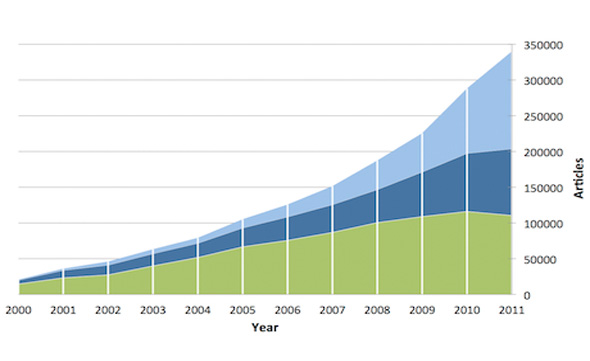A new study shows that the rise of open access publishing of academic research is faster than anyone had previously realized. Before 2000 the vast majority of research papers were published in journals that could only be read by academics if they — or their university libraries — paid a subscription. But since the turn of the millennium, the growth of the world wide web has been accompanied by the emergence of open access publishing, by which research papers are made freely available online.
The academic publishing game has changed irrevocably.
The change does not mean that academics have embraced the free-for-all file-sharing mentality that is the bug-bear of the music business. Rather it reflects the deep-seated amateur ethos of scholars, who have always seen the work of producing and reviewing their research findings as an intrinsic part of the job. While the dissemination of that research relied on the printing and distribution of academic journals, the publishers’ subscription model was a sensible way to manage this business. But the opportunities provided by the web for instant distribution has fused with the principle that publicly funded research should be freely available and propelled the open access movement to the forefront of academic publishing. The escape from the physical bounds of publishing on paper should also help us to realize significantly better value for money in this core part of the research enterprise.
The rise of open access has been hampered by opposition from some publishers, who see it as a threat to a lucrative subscription model, and by some quarters of the research community fearful of jettisoning an established process of publishing in familiar journals. Scientists may have invented the internet but some remain suspicious of its fast-moving and disruptive nature. Others, myself included, are more sanguine about the promise of open access, as indeed is the UK government. In July this year science minister David Willetts warmly welcomed the report of the working group led by Dame Janet Finch on how to expand access to publicly funded research. The government sees open access as a way of accelerating the free distribution of scientific results, not just to researchers but also to businesses looking to innovate new technologies, and as a necessary mechanism for developing new computer-based text and data-mining methods for interrogating research results with a breadth and depth that no individual could hope to match. Finch’s recommendations are now being implemented as policy by Research Councils UK, the body that oversees public spending on science and the humanities. In a bold move, the UK has committed itself to ensuring that from April 2013 all publicly funded research papers will be available free to readers.
The policy is not without its critics, many of whom are concerned about the cost implications, since the new policy has a strong preference for facilitating free access by paying publishers an “article processing charge” (APC) to ensure the paper is made freely available upon publication (one of the forms of gold open access). The cost calculations are uncertain but may be as high as £60m per year, which will have to come from the research budget, a sore point with researchers in these austere times.
A cheaper green route is also available, whereby the author usually deposits an unformatted version of the paper in a university repository without incurring a publisher’s charge, but it remains to be seen if this will be adopted in practice. Universities and research institutions are only now beginning to work out how to implement the new policy (recently clarified by the RCUK).
They should be encouraged by Laasko and Björk’s study which, fittingly, is published in an open access journal. The Finnish researchers found not only that nearly 17% of research papers worldwide are now published in open access journals, a figure that is two to three times higher than was previously supposed, but also that the exponential rise in open access publishing shows no sign of slowing down.
In the UK, since about 35% of papers are reckoned to be made available through deposition in repositories — the green route — the total percentage of open access papers (52%*) looks like it has crossed the half-way mark. Whatever the difficulties universities and researchers might face in implementing the new RCUK policy, it is clear that there is no going back. We can look forward to a future in which there is a much freer access to research results, both for researchers, businesses and the public. The only question now is what can we do with it?







Leave a Reply